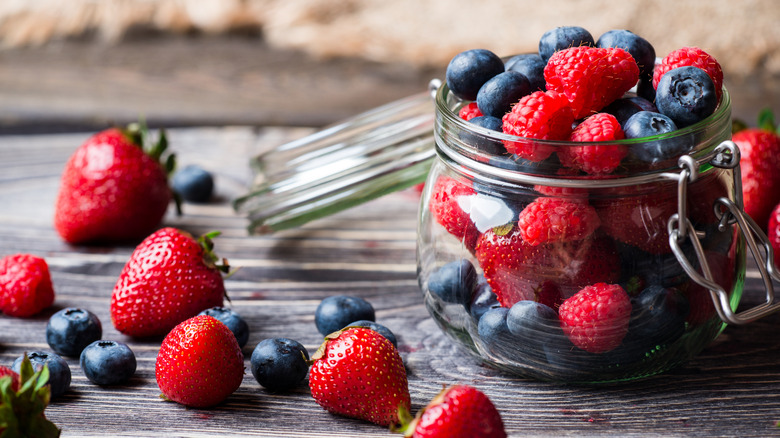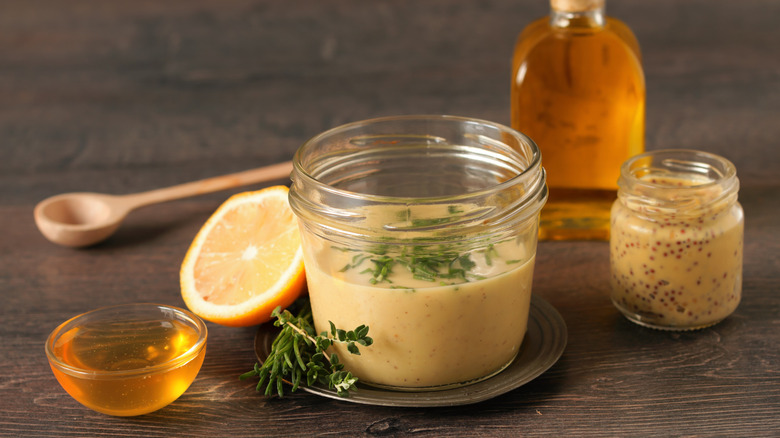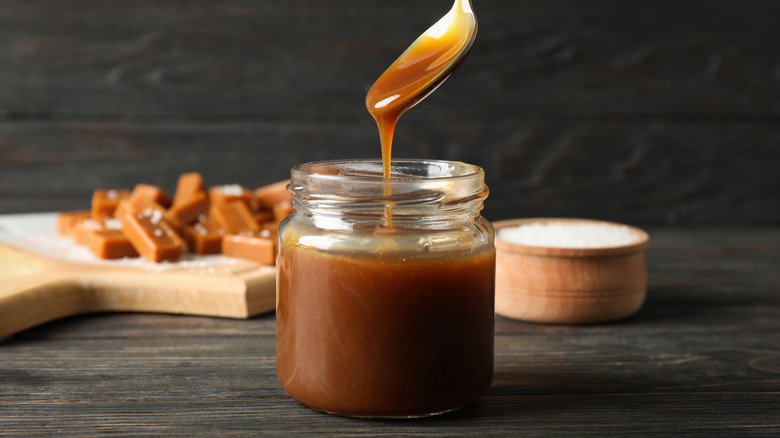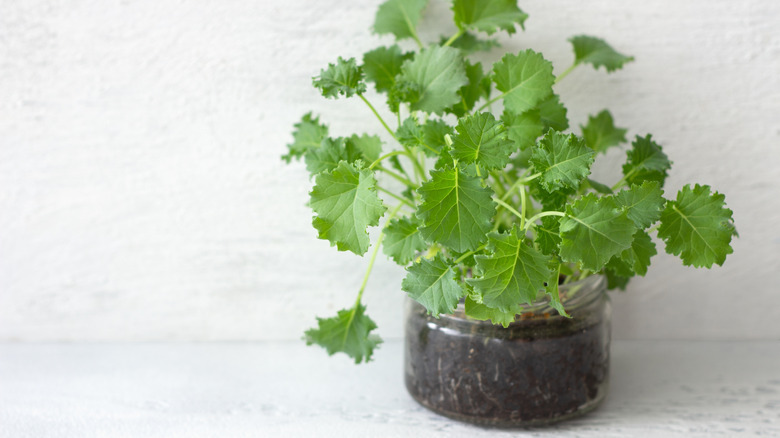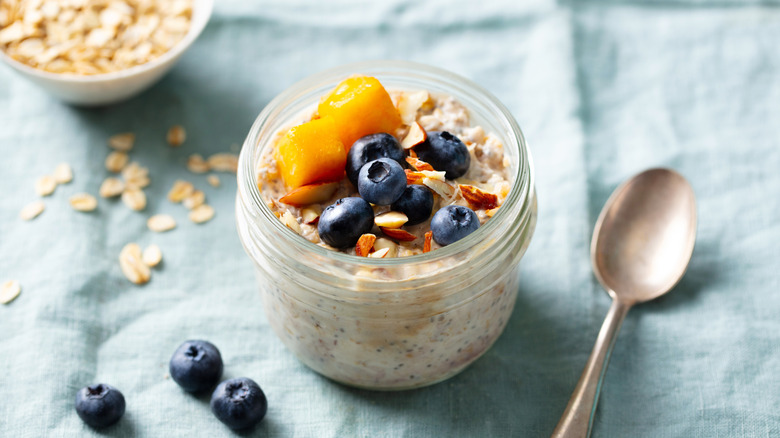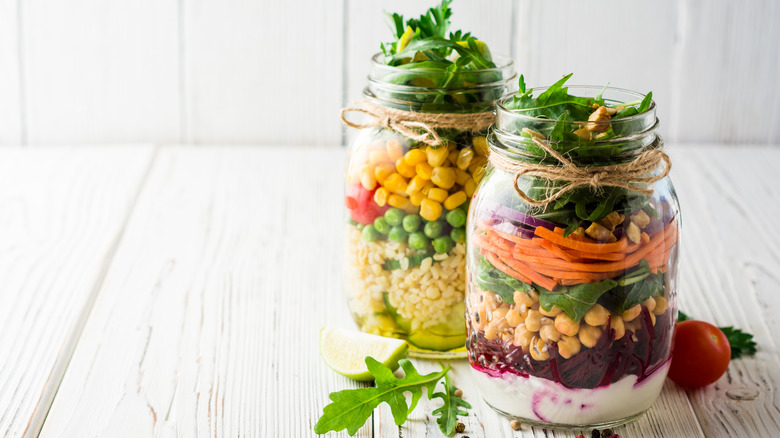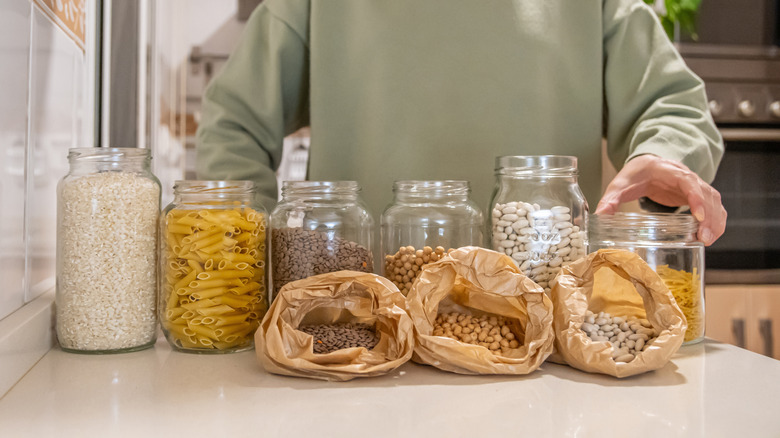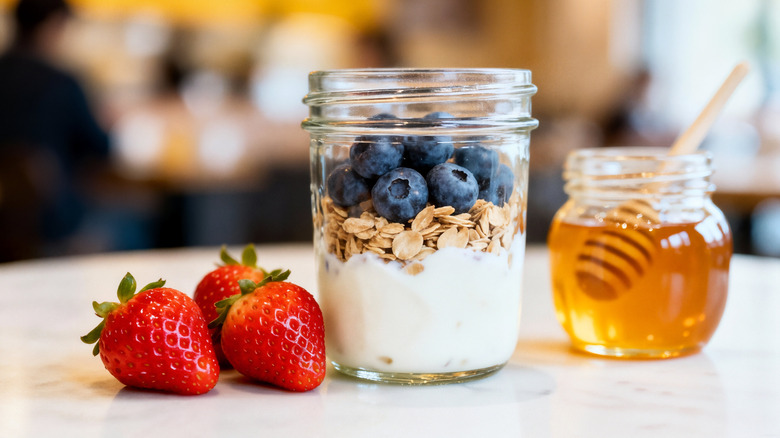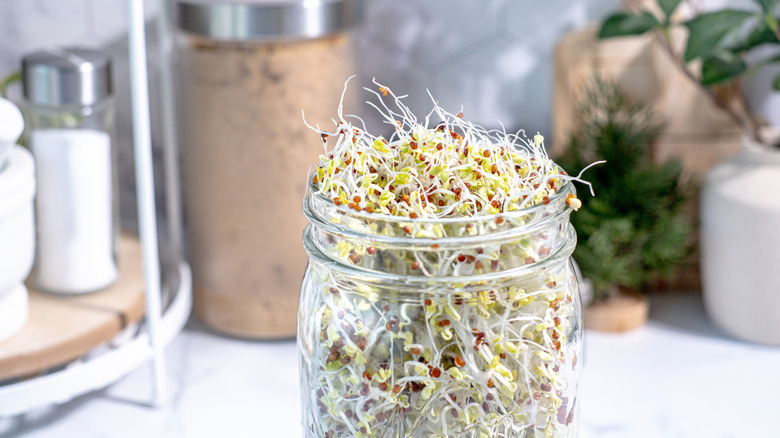Why You Should Never Throw Away Old Jars And Condiment Bottles
You may think that nearly empty pickle jar in your fridge is taking up too much space, and you're just itching to finish the pickles so you can toss it in the recycle bin where it belongs. But why would you pitch a perfectly usable jar when you have already paid for it, along with the pickles that were inside? Go ahead and finish the gherkins — but then there are so many reasons for you to hold onto the empty jar and put it to its most valuable uses.
Simply put, food jars and condiment bottles are free storage containers that let you avoid microplastics. Being inundated with tiny bits of polymers that can infiltrate our bodies is frightening enough to create a seismic food storage shift. With so many of the products we buy on a regular basis arriving in glass jars and bottles, there's an immediate supply of replacement containers just waiting to be utilized instead of being thrown away.
If you've never tried using your jars and bottles from spreads, condiments, drinks, and more, you might need a little inspiration to get the ball rolling. These 15 ideas for repurposing food jars and condiment bottles are some of the best ways for putting your bonus containers to work for you.
Store leftovers
Why pay top dollar (or even bottom dollar) for a set of lidded glass food storage containers when you already have a growing collection in your fridge and pantry? Every time you finish your instant coffee or grape jelly, you end up with the perfect vessel for holding leftovers, with metal lids that beat plastic lids which can crack over time, compromising freshness.
The most obvious choices for storing in jars are foods that come in jars already. Items like soups and stews make great candidates; not only can they store long-term in a tightly-lidded jar, you can ration out portions in different size jars for lunch and dinner reheats. Similarly, pasta and sauces can be dropped into the same jar to save space in the fridge and make ready-to-heat future meals.
To avoid causing your jar to crack in the microwave, it's safest to reheat your stored leftovers in a microwave-safe bowl. And of course, the metal lids can't go in the microwave, so finding a dish that works is the best approach.
Keep fruit fresh longer
If you have hit-or-miss luck like I do with keeping refrigerated fruit from going mushy in the produce drawers, glass jars are the solution you've been looking for. This is especially true for storing berries, which tend to soften relatively quickly. Glass jars with tight fitting lids provide a more airtight and well-chilled environment for these tender fruits to avoid softening, which keeps you feeling like you have to scramble to eat them as quickly as possible.
There's a trick to getting the best results though; washing and drying your berries as best you can before placing them in the jar helps prevent the fruit from breaking down. Because fruit may respire and produce condensation while in the jar, placing a square of paper towel inside will absorb any moisture that arises to extend the life of your progress. I've been able to make a carton of strawberries last for three weeks or more with this method. Apple slices, chopped bananas, and peeled orange slices, especially smaller clementines, all do extremely well in a re-purposed glass jar, too.
Make homemade dressings
Expand your culinary know-how by mixing up your own dressings for salads and vegetables using your empty salsa jars. They're the ideal size for setting all the ingredients you need and preparing a large enough quantity to last for a couple weeks. Bonus points if you have salad dressing bottles that you can reuse for the same purpose.
Simple dressings that use equal parts neutral oil and vinegar with liberal amounts of your favorite savory seasonings plus a dash of salt and pepper are recipes anyone can conquer. Twist the lid on tight and shake your ingredients until they're well incorporated — another handy task that reusable jars are good for. If your recipe calls for an immersion blender, be sure to choose a jar with a large enough opening to accommodate your device.
Should you wonder what to do with leftover olive juice once the solids are all used up, explore the possibilities of making fantastic tangy dressings using the liquid directly in the jar. You can also avoid mistakes people make with salad dressings by researching recipes that get the balance just right.
Fill them with handcrafted syrups
It's easier than you think to create your own homespun syrups for coffee, desserts, and cocktails. With leftover caper or olive jars on hand, you have ideal storage containers that can accommodate a batch of simple syrup. Mix together one cup of water with one cup of granulated sugar and a few drops of vanilla extract in a sauce pot until the sugar dissolves, then simmer on low while watching for steam to rise. When the syrup clings to the back of a metal spoon, remove the pot from the heat and let it cool before pouring into a clean jar. The syrup will thicken even more as it cools.
Other sauces work just as well, whether it's something sweet like indulgent chocolate gravy, salted caramel glaze, or a savory Thai peanut sauce. Having jars on hand to store the finished product may inspire you to get creative with sauces for all kinds of occasions. Remember that these fresh sauces may not last as long as store-bought, so consider marking your jar with the date so you'll know when to switch out the contents.
Start your own herb garden
Fresh herbs are so much better than dried when making many home-cooked meals, and condiment bottles provide handy containers for getting your own herbs growing on your kitchen counter. Start your seeds sprouting by placing them in wet paper towels inside the jar. Once you have sprouts, you can transfer them into a larger jar filled with soil.
For some herbs, clippings can be used to start a new plant by letting the stem rest in a jar of water until a root develops. Transplanting the sprig in water will help the new rootlings grow larger. You can even use the original jar by filling it with soil and gently nesting the rootling into the surface. Place it in a sunny window and water as needed to make your new herb garden flourish.
If all else fails, you can get a few weeks' life out of the clusters of soft herbs you get at the grocery store or farmers market by storing them stems-down in a jar of water in the fridge.
Make overnight oats
The luscious texture of homemade overnight oats gives this breakfast classic a more indulgent consistency than cooking them the old-fashioned way. Jelly jars are the perfect size for doling out one or two servings without having to turn on the stove. The basic formula is a one-to-one ratio of oats to liquid, with rolled oats working better than quick oats, as they absorb the liquid better.
Straightforward water and oats will produce a blank slate ready to take on your favorite flavorings, though you can incorporate other elements in the jar like Greek yogurt to increase the flavor and texture. Try dropping in chopped pineapple and coconut with a little maple syrup or a scoop of peanut butter, and a teaspoon or two of cocoa powder with a little turbinado sugar. Mix well or fasten the lid and shake up your combination before stashing it in the fridge for its overnight cold bath.
To make things more interesting, try different recipes in a few jars and taste test them with your family in the morning. They'll help you choose which of your jarred breakfast creations is worth repeating.
Make chia pudding
One of the healthiest uses for your leftover jars and bottles is making simple chia pudding. Though the name sounds like this concoction is strictly for dessert, it also makes a highly nutritious and tasty breakfast or snack dish as well. All it takes is whole chia seeds mixed with water, juice, or milk. Fasten the lid on the jar tightly and place it in the refrigerator for several hours, and ideally overnight. The chia seeds will release a gel-like substance that thickens the mixture and creates a consistency similar to tapioca pudding.
Get more out of your jarred chia pudding by adding a bit of fruit juice or coconut milk and stirring in fresh fruit for a brightly flavored breakfast bite. You can also opt for an easier version that uses just a bit of maple syrup or honey to sweeten the milky concoction instead. Experiment with recipes for pudding lovers that use chia pudding as a base, and see how far you can take this easy jarred dessert treat.
Use them for meal prep
Meal preppers often depend on reusable plastic containers as their tote-along food holders, exposing themselves to a daily dose of micro plastics along with their healthy selections. Larger jars like soup or pickle jars provide ample room for layered creations that can be labeled and shelved in the fridge for a week's worth of pre-made lunches or dinners.
Ingredients that combine naturally work best for jarred food prep. Rather than choosing recipes where each component gets its own separate compartment, try recipes that allow the food to stack or even mixed together. Some possibilities include rice and vegetable dishes, whole grain or protein pastas with lean meats or tofu, and three bean salads with a simple oil and vinegar dressing.
One of the great benefits of using existing jars is having a range of sizes for different meals. A smaller jar from a pricey jelly might be a great fit for a light breakfast combo, while a sturdier jar from mayonnaise or pasta sauce could be the right size for larger lunch or dinner mixes.
Make simple pickles
Why toss the pickle juice out of your empty pickle jar when you're just going to go buy more pickles to replace them both? With a jar full of refrigerated brine at the ready and a cucumber or two, you have all the makings of simple homemade refrigerator pickles that bring fresh possibilities to your salads and sandwiches.
An even easier version entails using the existing brine in the jar to pickle slices of fresh cucumber. You can go for traditional circular slices or get fancy with longer spears, as long as your slices are covered entirely by the brine in the jar. Let them sit in the fridge for at least a couple days for maximum tanginess and softness, though be prepared for pickles that are slightly firmer than the store-bought kind.
Anyone who grows their own cucumbers has access to organic, homespun pickles, too. The salt in the brine will help your homemade pickles stay fresh for quite a while, though writing the date on a label or on the lead of the jar will help you keep track of each jar's age.
Store bulk foods
Reduce your single use plastic consumption even further by shopping at bulk food stores and using your empty jar collection to keep purchases fresh and shelf-ready. Most bulk food stores utilize produce-style plastic bags with twist tie tags to identify the contents. If you make regular purchases in bulk, you can retain the bags and the tags and use them on future trips to minimize waste. Just be sure to write the name of the item on the tag and keep it with the bag to avoid cross-contamination of your purchases.
When you get home, empty your bulk items into the proper size jar to accommodate the quantity and store them where appropriate, either in the fridge or a pantry or cabinet. Not only will you have upright storage that gives you a clear view of what's in each jar and how much you still have on hand, you'll also reduce your exposure to micro plastics by not keeping your food in those bulk plastic bags for longer than necessary.
Make take-and-go yogurt parfaits
Reinvent breakfast as a premade meal ready to grab and eat on the run by using your repurpose jars as yogurt parfait containers. It's the perfect layered creation to assemble in an olive jar, which gives ideal proper portioning while giving you a window into what each parfait contains. Make a week's worth on the weekend and keep them chilled in the fridge so you can snag one in the morning and enjoy it once you get to work.
For a healthier yogurt parfait option, stick with plain Greek yogurt, which has more protein and less sugar than other yogurts. Gather an array of small fruits like blueberries or strawberry slices, dried fruits such as pineapple and coconut, and granola or other sturdy dry cereal and alternate layers in the jar as you build your parfait. If you're making a variety of combinations, label each to make sure you and your family members know what's inside each jar.
Grow broccoli sprouts
Health minded eaters who've never tried growing their own broccoli sprouts in an empty jar are in for a nutrient-dense treat. Broccoli sprout seeds are easily found online and sold in quantities that allow for repeated crops, so it's easy to experiment with your leftover salsa, soup, or other widemouthed jars.
To get your seeds ready, drop a couple tablespoons into an empty jar and fill it about halfway with filtered water. Tighten the lid to create the right environment for the seeds to sprout, and let them soak for between six and eight hours. Then, carefully drain off the old water, swirl in new water to rinse the seeds, and drain that, too. Repeat the process two to three times a day, and in a few days, you should have nutrient-dense broccoli sprouts to eat.
Drainage is important, so you may need to tilt your jar in a bowl with the lid off to let the residual water seep out. Once you get the hang of it, you can add greens to your salads, smoothies, or sandwiches for a blast of micronutrients.
Refill them with custom spreads
Who says you need a grocery store to replenish your stock of peanut butter and jelly? Once you've scraped the last bit out of your glass jars, all it takes is a bag of peanuts and a carton of fresh strawberries or blueberries to re-create the contents in a much healthier version, one where you control the sugar.
To make your own homemade peanut butter, add roasted peanuts to a food processor and blend until smooth. It may take a little longer than expected since breaking down the meat of the nuts to get to the oil requires a great deal of processing. Keep scraping the sides down between blendings and watch for the silky smoothness to know when your butter is ready. Add a drop of oil or water to thin it out further if you want, plus a little salt for flavor. You can make similar butters with sunflower seeds and almonds.
For three-ingredient homemade blueberry jam, add berries, lemon juice, and sugar to a sauce pan and let it boil, stirring until the fruit breaks down and the sugar dissolves. The mixture will reduce and congeal as it cooks. Let it cool and thicken before spooning it into a clean jar.
Turn them into food gift containers
It may be easy to pick up a box of Ball jars at the store when you're considering making your own variety of homemade food gifts for the holidays. But an enterprising cook will collect up empty jars of various shapes and sizes throughout the year and utilize them as vessels to save money and add a splash of homemade charm to the finished product.
Cookie and cake mixes are popular versions of jarred food gifts, featuring layers of flour, sugar, baking soda, and chocolate chips in an arrangement that looks pretty sitting on the counter until it's ready to be used. But you can take the concept further by filling your empty jars with holiday bark, spiced nuts, or homemade hot chocolate mix.
Include a handwritten tag hung from ribbon tied around the neck of the bottle describing the contents and giving any necessary prep instructions, and you have an eclectic and thoughtful reinvention of the homemade food gift.
Store custom spice blends
Home cooks who have their own secret recipe for herb and spice blends can whip up a batch all at once rather than having to dole out spoonfuls of six or seven spices every time they cook. It's as easy as rounding up the bottles of seasonings and spices from your cabinet and doubling your tripling the quantities you usually use in a single recipe. Shake it all up to incorporate and you have a jarful of pre-mixed flavoring prepped to scoop in a single swoop. Think of all the dishes and drinks you could add homemade pumpkin spice to with a jar of the magic powder ready and waiting.
This works great to bring your various existing spices together, but once you've used through your supply, you'll need to purchase more, which likely means buying many little plastic bottles. Consider visiting a bulk spice shop to make your purchases in alternative paper bags to reduce plastic waste. You might even be able to bring your jars and have the clerk weigh your spices as you buy them, then drop them into your jar to make the mix as you go. It's the ultimate in reducing, reusing, and recycling your jars and condiment bottles, and all it takes is a little forethought to put it into action.


